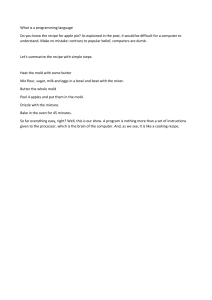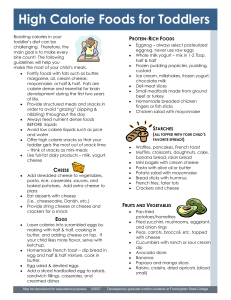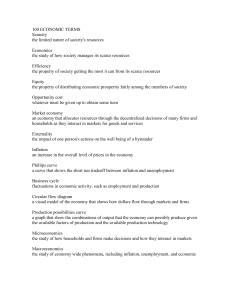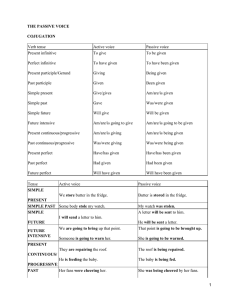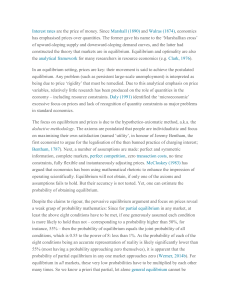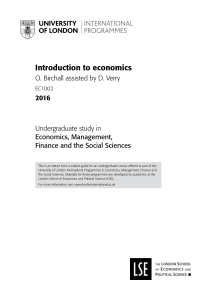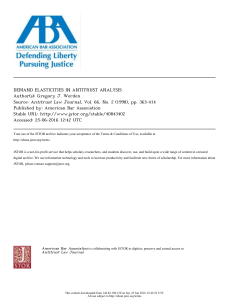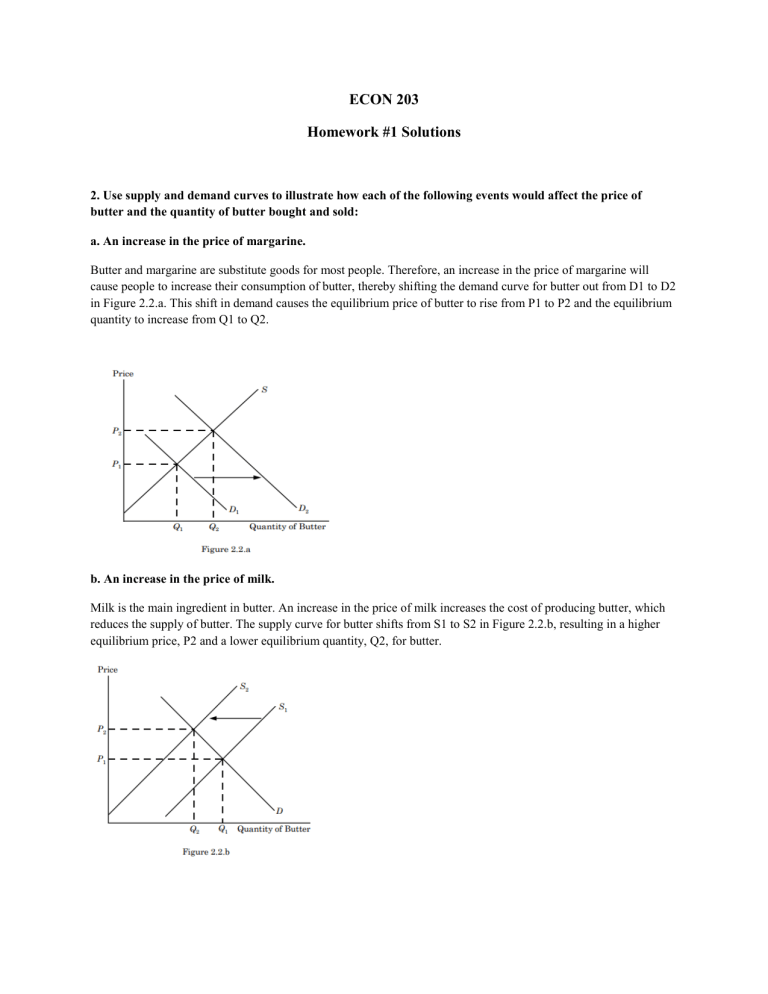
ECON 203 Homework #1 Solutions 2. Use supply and demand curves to illustrate how each of the following events would affect the price of butter and the quantity of butter bought and sold: a. An increase in the price of margarine. Butter and margarine are substitute goods for most people. Therefore, an increase in the price of margarine will cause people to increase their consumption of butter, thereby shifting the demand curve for butter out from D1 to D2 in Figure 2.2.a. This shift in demand causes the equilibrium price of butter to rise from P1 to P2 and the equilibrium quantity to increase from Q1 to Q2. b. An increase in the price of milk. Milk is the main ingredient in butter. An increase in the price of milk increases the cost of producing butter, which reduces the supply of butter. The supply curve for butter shifts from S1 to S2 in Figure 2.2.b, resulting in a higher equilibrium price, P2 and a lower equilibrium quantity, Q2, for butter. Note: Butter is in fact made from the fat that is skimmed from milk; thus butter and milk are joint products, and this complicates things. If you take account of this relationship, your answer might change, but it depends on why the price of milk increased. If the increase were caused by an increase in the demand for milk, the equilibrium quantity of milk supplied would increase. With more milk being produced, there would be more milk fat available to make butter, and the price of milk fat would fall. This would shift the supply curve for butter to the right, resulting in a drop in the price of butter and an increase in the quantity of butter supplied. c. A decrease in average income levels. Assuming that butter is a normal good, a decrease in average income will cause the demand curve for butter to decrease (i.e., shift from D1 to D2). This will result in a decline in the equilibrium price from P1 to P2, and a decline in the equilibrium quantity from Q1 to Q2. See Figure 2.2.c. 3. If a 3-percent increase in the price of corn flakes causes a 6-percent decline in the quantity demanded, what is the elasticity of demand? The elasticity of demand is the percentage change in the quantity demanded divided by the percentage change in the price. The elasticity of demand for corn flakes is therefore 5. Explain why for many goods, the long-run price elasticity of supply is larger than the short-run elasticity. The price elasticity of supply is the percentage change in the quantity supplied divided by the percentage change in price. In the short run, an increase in price induces firms to produce more by using their facilities more hours per week, paying workers to work overtime and hiring new workers. Nevertheless, there is a limit to how much firms can produce because they face capacity constraints in the short run. In the long run, however, firms can expand capacity by building new plants and hiring new permanent workers. Also, new firms can enter the market and add their output to total supply. Therefore, the price elasticity of supply is larger in the long run than in the short run. 6. Why do long-run elasticities of demand differ from short-run elasticities? Consider two goods: paper towels and televisions. Which is a durable good? Would you expect the price elasticity of demand for paper towels to be larger in the short run or in the long run? Why? What about the price elasticity of demand for televisions? Long-run and short-run elasticities differ based on how rapidly consumers respond to price changes and how many substitutes are available. If the price of paper towels, a non-durable good, were to increase, consumers might react only minimally in the short run- because it takes time for people to change their consumption habits. In the long run, however, consumers might learn to use other products such as sponges or kitchen towels instead of paper towels. In this case, then, the price elasticity would be larger in the long run than in the short run. In contrast, the quantity demanded of durable goods, such as televisions, might change dramatically in the short run following a price change. For example, the initial result of a price increase for televisions would cause consumers to delay purchases because they could keep using their current TVs longer. Eventually consumers would replace their televisions as they wore out or became obsolete. Therefore, we expect the demand for durables to be more elastic in the short run than in the long run. 7. Are the following statements true or false? Explain your answers. a. The elasticity of demand is the same as the slope of the demand curve. False. Elasticity of demand is the percentage change in quantity demanded divided by the percentage change in the price of the product. In contrast, the slope of the demand curve is the change in quantity demanded (in units) divided by the change in price (typically in dollars). The difference is that elasticity uses percentage changes while the slope is based on changes in the number of units and number of dollars. b. The cross-price elasticity will always be positive. False. The cross price elasticity measures the percentage change in the quantity demanded of one good due to a one percent change in the price of another good. This elasticity will be positive for substitutes (an increase in the price of hot dogs is likely to cause an increase in the quantity demanded of hamburgers) and negative for complements (an increase in the price of hot dogs is likely to cause a decrease in the quantity demanded of hot dog buns). c. The supply of apartments is more inelastic in the short run than the long run. True. In the short run it is difficult to change the supply of apartments in response to a change in price. Increasing the supply requires constructing new apartment buildings, which can take a year or more. Therefore, the elasticity of supply is more inelastic in the short run than in the long run, or said another way, the elasticity of supply is less elastic in the short run than in the long run. 8. Suppose the government regulates the prices of beef and chicken and sets them below their marketclearing levels. Explain why shortages of these goods will develop and what factors will determine the sizes of the shortages. What will happen to the price of pork? Explain briefly. If the price of a commodity is set below its market-clearing level, the quantity that firms are willing to supply is less than the quantity that consumers wish to purchase. The extent of the resulting shortage depends on the elasticities of demand and supply as well as the amount by which the regulated price is set below the market-clearing price. For instance, if both supply and demand are elastic, the shortage is larger than if both are inelastic, and if the regulated price is substantially below the market clearing price, the shortage is larger than if the regulated price is only slightly below the market-clearing price. Factors such as the willingness of consumers to eat less meat and the ability of farmers to reduce the size of their herds/flocks will determine the relevant elasticities. Customers whose demands for beef and chicken are not met because of the shortages will want to purchase substitutes like pork. This increases the demand for pork (i.e., shifts demand to the right), which results in a higher price for pork. 10. In a discussion of tuition rates, a university official argues that the demand for admission is completely price inelastic. As evidence, she notes that while the university has doubled its tuition (in real terms) over the past 15 years, neither the number nor quality of students applying has decreased. Would you accept this argument? Explain briefly. (Hint: The official makes an assertion about the demand for admission, but does she actually observe a demand curve? What else could be going on?) I would not accept this argument. The university official assumes that demand has remained stable (i.e., the demand curve has not shifted) over the 15-year period. This seems very unlikely. Demand for college educations has increased over the years for many reasons − real incomes have increased, population has increased, the perceived value of a college degree has increased, etc. What has probably happened is that tuition doubled from T1 to T2, but demand also increased from D1 to D2 over the 15 years, and the two effects have offset each other. The result is that the quantity (and quality) of applications has remained steady at A. The demand curve is not perfectly inelastic as the official asserts. 11. Suppose the demand curve for a product is given by Q = 10 − 2P + PS, where P is the price of the product and PS is the price of a substitute good. The price of the substitute good is $2.00. a. Suppose P = $1.00. What is the price elasticity of demand? What is the cross-price elasticity of demand? Find quantity demanded when P = $1.00 and PS = $2.00. Q = 10 − 2(1) + 2 = 10. Price elasticity of demand = b. Suppose the price of the good, P, goes to $2.00. Now what is the price elasticity of demand? What is the cross-price elasticity of demand? 13. Suppose the demand for natural gas is perfectly inelastic. What would be the effect, if any, of natural gas price controls? If the demand for natural gas is perfectly inelastic, the demand curve is vertical. Consumers will demand the same quantity regardless of price. In this case, price controls will have no effect on the quantity demanded, but they will still cause a shortage if the supply curve is upward sloping and the regulated price is set below the market-clearing price, because suppliers will produce less natural gas than consumers wish to purchase . EXERCISES 1. Suppose the demand curve for a product is given by Q = 300 – 2P + 4I, where I is average income measured in thousands of dollars. The supply curve is Q = 3P – 50. a. If I = 25, find the market clearing price and quantity for the product . b. If I = 50, find the market clearing price and quantity for the product. 2. Consider a competitive market for which the quantities demanded and supplied (per year) at various prices are given as follows: a. Calculate the price elasticity of demand when the price is $80 and when the price is $100. b. Calculate the price elasticity of supply when the price is $80 and when the price is $100. c. What are the equilibrium price and quantity? The equilibrium price is the price at which the quantity supplied equals the quantity demanded. As we see from the table, the equilibrium price is P* = $100 and the equilibrium quantity is Q* = 18 million. d. Suppose the government sets a price ceiling of $80. Will there be a shortage, and if so, how large will it be? With a price ceiling of $80, price cannot be above $80, so the market cannot reach its equilibrium price of $100. At $80, consumers would like to buy 20 million, but producers will supply only 16 million. This will result in a shortage of 4 million.

